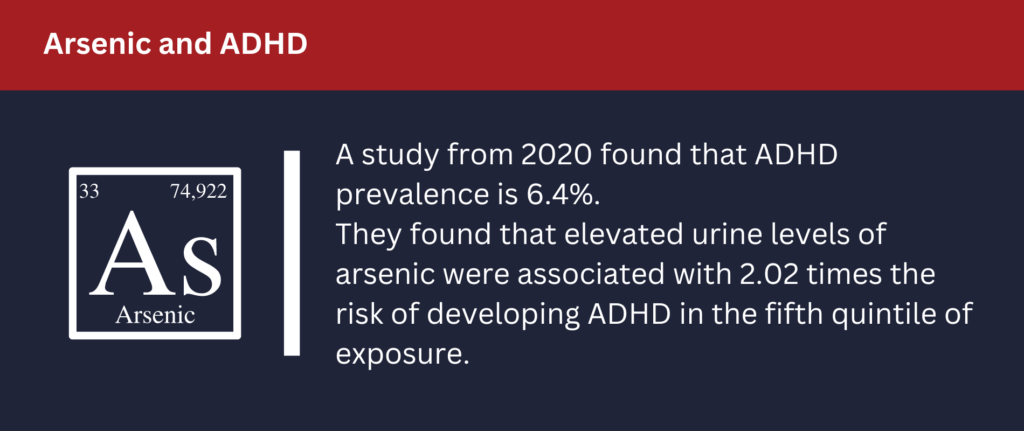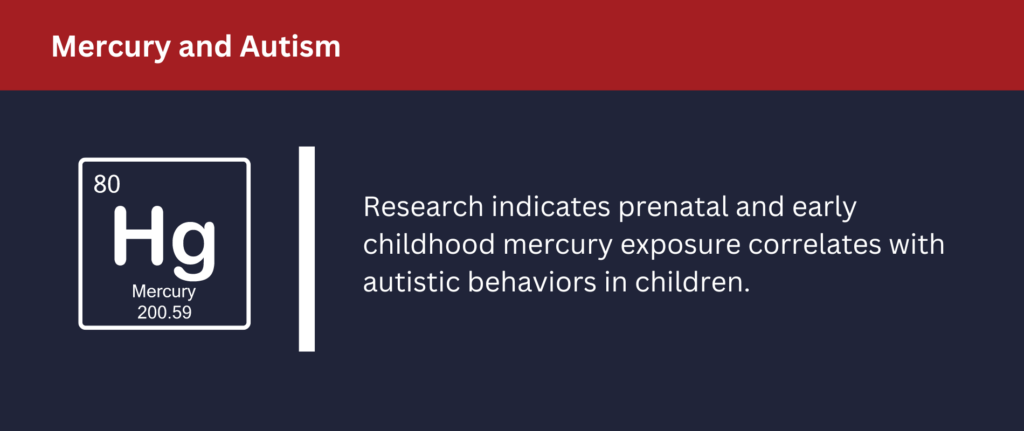
A February 2021 Congressional Staff Report found that some baby foods exceeded FDA allowable levels for lead, arsenic, cadmium and mercury by 177 times, 91 times, 69 times and 5 times, respectively.
Unfortunately, these heavy metals have been linked to a host of health problems, including:
- Autism
- ADHD
- Neurotoxic effects
- Cancer
- Cardiovascular issues
- Brain damage
- Compromised immune system
The Staff Report found elevated levels of heavy metals in baby foods made by the following brands:
- Gerber
- Beech-Nut
- Happy Family Organics
- Happy Baby
- Sprout Organic Food
- Earth’s Best Organics
- Parent’s Choice
These heavy metals found in baby foods have been linked to ADHD and autism by numerous scientific studies:
Arsenic And ADHD

Attention deficit hyperactivity disorder and its association with heavy metals in children from northern Chile, published in the May 2020 in International Journal of Hygiene and Environmental Health, analyzed data on 2,656 between the ages of 3 and 17. ADHD was diagnosed based on parents’ responses to health history questions. The study found an ADHD prevalence of 6.4%.
The researchers found that elevated urine levels of arsenic were associated with 2.02 times the risk of developing ADHD in the fifth quintile of exposure.
Lead And ADHD
Attention deficit hyperactivity disorder and its association with heavy metals in children from northern Chile also found that blood lead concentrations of 5 μg/dl or more were associated with 2.33 times the risk of developing ADHD.
The Association between Lead and Attention-Deficit/Hyperactivity Disorder: A Systematic Review, published in January 2019 in International Journal of Environmental Research and Public Health, examined 17 studies carried out on children in the previous five years. The researchers concluded that “there is an association between lead and ADHD and that even low levels of lead raise the risk.”
Lead and Attention-Deficit/Hyperactivity Disorder (ADHD) symptoms: a meta-analysis, published in January 2013 in Clinical Psychology Review, examined 33 studies published between 1972 and 2012 involving 10,232 children. The researchers concluded that there is a small to medium association between lead exposure, inattention symptoms and hyperactivity/impulsivity symptoms.
Mercury And ADHD
Prenatal exposure to mercury and fish consumption during pregnancy and attention-deficit/hyperactivity disorder-related behavior in children, published in December 2012 in Archives of Pediatrics and Adolescent Medicine, analyzed data for 8 year-old children with peripartum maternal hair mercury measures. The researchers found that low-level prenatal mercury exposure was associated with a greater risk of inattentive and impulsive/hyperactive behaviors.
Cadmium And ADHD

Heavy Metals’ Effect on Susceptibility to Attention-Deficit/Hyperactivity Disorder: Implication of Lead, Cadmium, and Antimony, published in June 2018 in International Journal of Environmental Research and Public Health, recruited 76 patients with ADHD and 46 healthy control children. The study concluded that cadmium was associated with susceptibility to ADHD and symptom severity in school-age children.
Metal and essential element concentrations during pregnancy and associations with autism spectrum disorder and attention-deficit/hyperactivity disorder in children, published in July 2021 in Environment International, studied 705 children with ADHD, 397 children with autism spectrum disorder and 1,034 control children. The researchers identified a positive association between ADHD and prenatal exposure to cadmium.
Arsenic And Autism
Exposure to Inorganic Arsenic and Lead and Autism Spectrum Disorder in Children: A Systematic Review and Meta-Analysis, published in October 2019 in Chemical Research in Toxicology, examined 14 studies on inorganic arsenic exposure and its association with autism spectrum disorder. The researchers condluded that “there is consistent evidence supporting a positive association” between early life exposure to inorganic arsenic and autism spectrum disorder diagnosis.
Blood Mercury, Arsenic, Cadmium, and Lead in Children with Autism Spectrum Disorder, published in January 2018 in Biological Trace Element Research, recruited 180 unrelated children with autism spectrum disorder and 184 healthy control children. The researchers found that the children with autism spectrum disorder had significantly higher blood levels of arsenic.
Lead And Autism
Autism spectrum disorder prevalence and associations with air concentrations of lead, mercury, and arsenic, published in July 2016 in Environmental Monitoring and Assessment, examined data on 4,486 children with autism spectrum disorder. The researchers found that children in geographic areas with higher air concentrations of lead had significantly higher prevalence of autism spectrum disorder.
Assessment of Hair Aluminum, Lead, and Mercury in a Sample of Autistic Egyptian Children: Environmental Risk Factors of Heavy Metals in Autism, published in October 2015 in Behavioural Neurology, studied 100 children with autism spectrum disorder and 100 control children. The researchers found that the levels of lead in the hair of the autistic children were significantly higher than the levels in the controls’ hair.
Mercury And Autism

Assessment of Hair Aluminum, Lead, and Mercury in a Sample of Autistic Egyptian Children: Environmental Risk Factors of Heavy Metals in Autism also found that the levels of mercury in the hair of the autistic children were significantly higher than the levels in the controls’ hair.
Blood Mercury, Arsenic, Cadmium, and Lead in Children with Autism Spectrum Disorder also found that the children with autism spectrum disorder had significantly higher blood levels of mercury.
Associations of prenatal and early childhood mercury exposure with autistic behaviors at 5 years of age: The Mothers and Children’s Environmental Health (MOCEH) study, published in December 2017 in Science of The Total Environment, analyzed 458 mother-child pairs, measuring blood mercury levels at early and late pregnancy, in cord blood, and at 2 and 3 years of age. The researchers found that higher blood mercury levels at early childhood and late pregnancy were associated with more autistic behaviors in 5 year-old children.
A Case-Control Study of Mercury Burden in Children with Autistic Spectrum Disorders, published in Summer 2003 in Journal of American Physicians and Surgeons, examined urinary mercury concentrations in 221 children with autism spectrum disorders and 18 control children. The researchers found that the children with autism spectrum disorders had significantly higher urinary mercury concentrations than the concentrations in the control children.
Cadmium And Autism
Metal and essential element concentrations during pregnancy and associations with autism spectrum disorder and attention-deficit/hyperactivity disorder in children also identified a positive association between autism spectrum disorder and prenatal exposure to cadmium.
Toxic Baby Food Lawyers
You may be eligible for financial compensation if your child, age 16 or younger, has been diagnosed with autism spectrum disorder after eating toxic baby food as an infant. Nadrich Accident Injury Lawyers is handling these cases on a no win, no fee basis, meaning we don’t charge a fee unless and until we obtain a recovery. Call us at 800-718-4658 for a free consultation.

